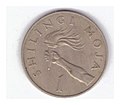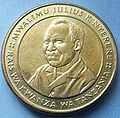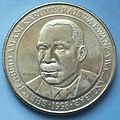Tanzanian shilling
Currency of Tanzania From Wikipedia, the free encyclopedia
The shilling (Swahili: shilingi; abbreviation: TSh; code: TZS) is the currency of Tanzania. It is subdivided into 100 cents (senti in Swahili). The Tanzanian shilling replaced the East African shilling on 14 June 1966 at par.[1]
| Shilingi za Kitanzania (Swahili) | |||||
|---|---|---|---|---|---|
| |||||
| ISO 4217 | |||||
| Code | TZS (numeric: 834) | ||||
| Subunit | 0.01 | ||||
| Denominations | |||||
| Subunit | |||||
| 1⁄100 | cent | ||||
| Banknotes | 500/=, 1,000/=, 2,000/=, 5,000/=, 10,000/= | ||||
| Coins | 50/=, 100/=, 200/=, 500/= | ||||
| Demographics | |||||
| User(s) | Tanzania | ||||
| Issuance | |||||
| Central bank | Bank of Tanzania | ||||
| Website | Bank of Tanzania website | ||||
| Valuation | |||||
| Inflation | 5.6% | ||||
| Source | The World Factbook, 2015 est. | ||||
Notation
Prices in the Tanzanian shilling are written in the form of x/y, where x is the amount above 1 shilling, while y is the amount in cents. An equals sign or hyphen represents zero amount. For example, 50 cents is written as "-/50" and 100 shillings as "100/=" or "100/-". Sometimes the abbreviation TSh is prefixed for distinction. If the amount is written using words as well as numerals, only the prefix is used (e.g. TSh 10 million).
This pattern was modelled on sterling's pre-decimal notation, in which amounts were written in some combination of pounds (£), shillings (s), and pence (d, for denarius). In that notation, amounts under a pound were notated only in shillings and pence.
Coins
Summarize
Perspective

In 1966, coins were introduced in denominations of -/5, -/10, -/20 and -/50 and 1/=, with the -/5 struck in bronze, the -/10 in nickel-brass (copper-nickel-zinc) and the -/50 and 1/= in cupro-nickel. Cupro-nickel 5/= coins were introduced in 1972, followed by scalloped, nickel-brass -/10 in 1977. This First Series coins set, in circulation from 1966 up to 1984, was designed by Christopher Ironside OBE.[2]
In 1987, nickel-plated steel replaced cupro-nickel in the -/50 and 1/=, and cupro-nickel 5/= and 10/= coins were introduced, with the 5/= decagonal in shape. In 1990, nickel-clad-steel 5/=, 10/= and 20/= were introduced, followed by brass-plated steel coins for 100/= in 1993, 50/= in 1996 and copper-nickel-zinc 200/= in 1998.
Coins currently in circulation are the 50/=, 100/=, 200/=, and 500/=. The 500/= coin was issued on 8 September 2014.[3]
Banknotes
Summarize
Perspective
On 14 June 1966, the Benki Kuu Ya Tanzania (Bank of Tanzania) introduced notes for 5/=, 10/=, 20/= and 100/=. The 5/= note was replaced by a coin in 1972. 50/= notes were introduced in 1985, followed by 200/= in 1986, 500/= in 1989 and 1,000/= in 1990. The 10/=, 20/=, 50/= and 100/= notes were replaced by coins in 1987, 1990, 1996 and 1994, respectively. 5,000/= and 10,000/= notes were introduced in 1995, followed by 2,000/= in 2003. A new series of notes came out in 2011. These new notes include many security features that prevent counterfeiting.[4][5]
Banknotes in circulation today are 500/=, 1,000/=, 2,000/=, 5,000/= and 10,000/=
| Older Series | |||||||||||
|---|---|---|---|---|---|---|---|---|---|---|---|
| Image | Value | Dimensions | Main Colour | Description | Date of issue | ||||||
| Obverse | Reverse | Obverse | Reverse | Watermark | |||||||
| 10/= | - | Green | Julius Nyerere | Arusha Declaration Monument | Giraffe | - | |||||
 |
20/= | - | Blue-violet | Julius Nyerere | General Tyre East Africa Plant | ||||||
 |
 |
100/= | - | Red | Julius Nyerere | Maasai | |||||
| 1997 Series[6] | ||||||||
|---|---|---|---|---|---|---|---|---|
| Image | Value | Dimensions | Main Color | Description | Date of issue | Watermark | ||
| Obverse | Reverse | |||||||
| 500 /= (Shilingi Mia Tano) | 138 x 69 mm | Green | Tanzanian coat of arms; Giraffe; Zebra | Clove harvest; Uhuru Torch | 1997 | Giraffe | ||
| 1000 /= (Shillingi Elfu Moja) | 142 x 71 mm | Red | Tanzanian coat of arms; Giraffe; African Elephant | Kiwira coal mine; Door of People's Bank of Zanzibar | ||||
| 1000 /= (Shilingi Elfu Moja) | 142 x 71 mm | Red | Tanzanian coat of arms; Julius Nyerere; African Elephant | Kiwira coal mine; Door of People's Bank of Zanzibar | 2000 | |||
| 5000 /= (Shillingi Elfu Tano) | 145 x 73 mm | Purple | Tanzanian coat of arms; Giraffe; Rhino | Giraffes; Mt Kilimanjaro | 1997 | |||
| 10,000 /= (Shilingi Elfu Kumi) | 149 x 75 mm | Indigo | Tanzanian coat of arms; Giraffe; Lion | Bank of Tanzania; "House of Wonder" (Zanzibar) | ||||
| These images are to scale at 0.7 pixel per millimetre. For table standards, see the banknote specification table. | ||||||||
| 2003 Series | |||||||||||
|---|---|---|---|---|---|---|---|---|---|---|---|
| Image | Value | Dimensions | Main Colour | Description | Date of issue | ||||||
| Obverse | Reverse | Obverse | Reverse | Watermark | |||||||
| 500/= | 130 × 63 mm | Green | African Buffalo | Nkrumah Hall, University of Dar es Salaam | Giraffe | 2003 | |||||
| 1,000/= | 135 × 66 mm | Blue | Julius Nyerere | Statehouse, Dar es Salaam | |||||||
 |
 |
2,000/= | 140 × 69 mm | Orange-brown | Lion, Mount Kilimanjaro | Old Fort, Stone Town, Zanzibar | |||||
 |
 |
5,000/= | 145 × 72 mm | Purple | Black Rhinoceros | Geita gold Mine and House of Wonders Zanzibar | |||||
 |
 |
10,000/= | 150 × 75 mm | Red | Elephant | Bank of Tanzania headquarters in Dar es Salaam | |||||
| These images are to scale at 0.7 pixel per millimetre. For table standards, see the banknote specification table. | |||||||||||
Currently in Circulation
| 2011 Series[7] | |||||||||
|---|---|---|---|---|---|---|---|---|---|
| Image | Values | Dimensions | Main Colour | Description | Date of issue | Date of first issue | Watermark | ||
| Obverse | Reverse | Obverse | Reverse | ||||||
 |
 |
500/= | 120 x 60 mm | Green | Tanzanian coat of arms; Sheikh Abeid Amani Karume | University of Dar es Salaam central hall building; graduating students wearing caps and gowns; Aesculap's rod | 2011 | 1 January 2010 | Julius Kambarage Nyerere with electrotype 500 |
 |
 |
1,000/= | 125 x 65 mm | Blue | Tanzanian coat of arms; President Julius Kambarage Nyerere; Bismarck Rock in Mwanza Harbor | Coffee plant; State House (Ikulu) building with flag in Dar es Salaam | Julius Kambarage Nyerere with electrotype 1000 | ||
 |
 |
2,000/= | 130 x 66 mm | Orange | Tanzanian coat of arms; Lion | Palm trees; old Omani Arab Fort (Ngome Kongwe) in Zanzibar's Stone Town; carved block | Julius Kambarage Nyerere with electrotype 2000 | ||
 |
 |
5,000/= | 135 x 67 mm | Purple | Tanzanian coat of arms; plant; black rhinoceros | Cyanid Leaching plant of the gold mines of Geita | Julius Kambarage Nyerere with electrotype 5000 | ||
 |
 |
10,000/= | 140 x 68 mm | Red | Tanzanian coat of arms; Elephant | Flowers; Bank of Tanzania headquarters building in Dar es Salaam | Julius Kambarage Nyerere with electrotype 10000 | ||
| These images are to scale at 0.7 pixel per millimetre. For table standards, see the banknote specification table. | |||||||||
See also
References
External links
Wikiwand - on
Seamless Wikipedia browsing. On steroids.























